Excerpts from Jim Conrad's
Naturalist Newsletter
Entry from field notes dated June 28, 2023, taken beside gravel road running beside the crest of the ridge rising on the southwestern side of Curva de la Doctorcilla, which is near km 18 on the branch road beginning at El Campamento and continuing to El Doctor, and which is numbered Hwy 120, though it branches off the main Hwy 120 running between San Juan del Río and Jalpan; limestone bedrock; elevation ~2930m (~9600 ft), Querétaro, MÉXICO, (N20.85971°, W99.60541°)
MEXICAN BROME
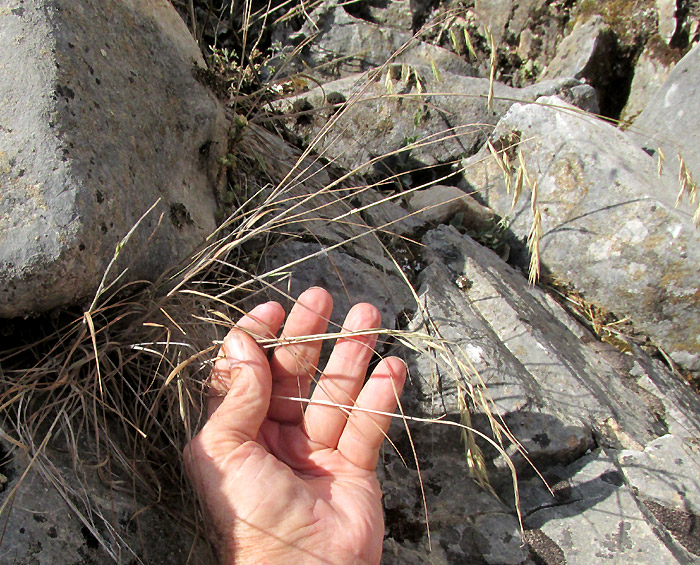
Beside the one-lane gravel road cut into the ridgetop, the above dried-out grass grew from cracks in the limestone roadcut. The spot was exposed to intense sunlight, wind and temperature extremes, yet the grass seemed to be thriving, so maybe it was a rare species highly adapted to such extreme environments. But grasses can be hard to identify, so to know how specialized the species was, it was a case of needing to "do the botany." Above, the first field marks noted were that it was a smallish species, and its fruiting spikelets drooped on long, slender pedicels.
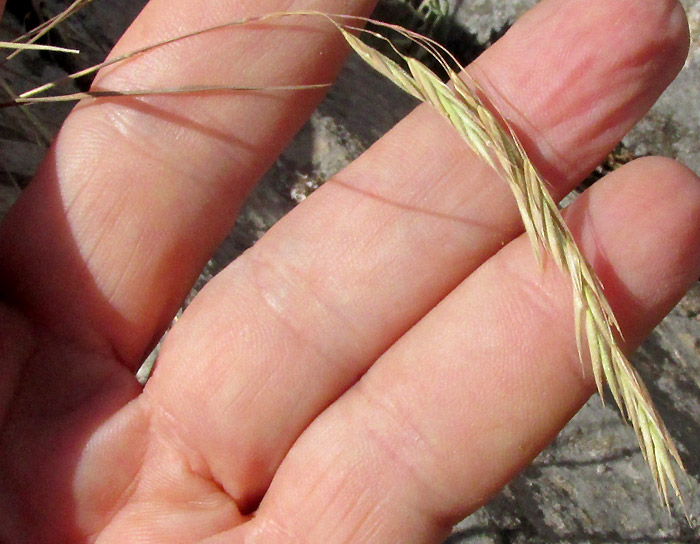
The above infructescence arises from a slender peduncle subtended by a short, narrow stem leaf. The whole infructecence consists of maybe 6-8 spikelets, each dangling on a slender pedicel. The spikelets group together in my hand, but a single one can be seen at the picture's top, center. Each spikelet produces about six florets.
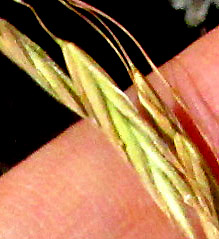
At the right, most of the picture is occupied by a single spikelet dangling from a slender pedicel. Notice that this spikelet's florets are subtended by two slender, sharp-pointed, scoop-shaped glumes of the same color and texture as the florets. The glumes are a little shorter than any of the spikelets. The florets are more rounded than flattened in cross section.
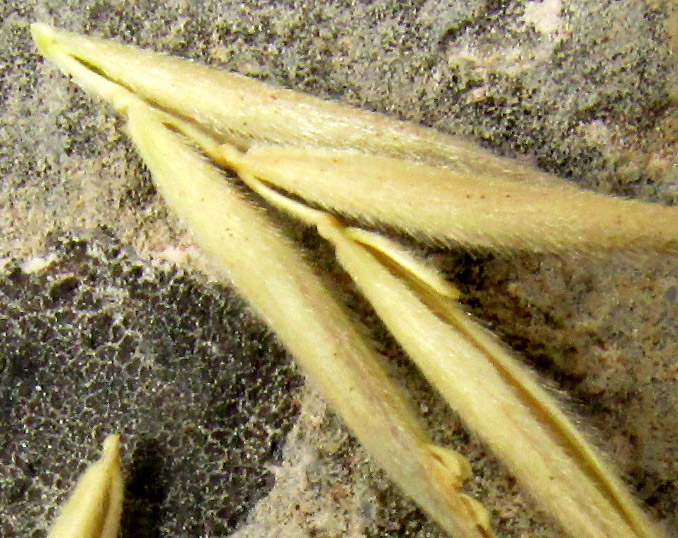
Above, a group of florets has broken from their spikelet. Important to notice for identification to the species level is that the florets' lemmas -- the papery coverings of each floret -- are densely short-hairy. Florets are arranged one above another along a jointed stem, or rachilla, which easily breaks at each joint, enabling each floret with its caryopsis-type, one-seeded fruit to be dispersed individually.
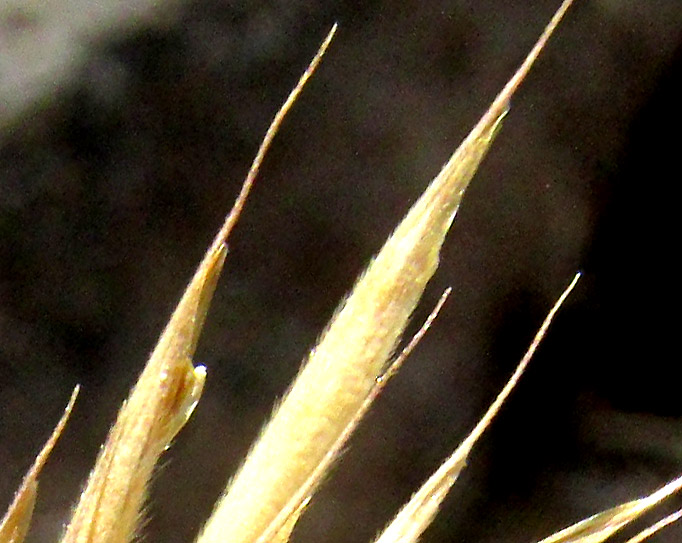
Above you see features important to notice for identification to genus level. The lemma of each floret is tipped with a needle-like awn. As awns go, these are fairly short. More important for defining the genus, though, is that the awns, instead of arising exactly from the lemmas' tips, arise a tiny bit behind the tips, and project out over the tip. Seeing that, along with other field marks noted above, the brome grasses come to mind, bromes being members of the moderately large genus Bromus.
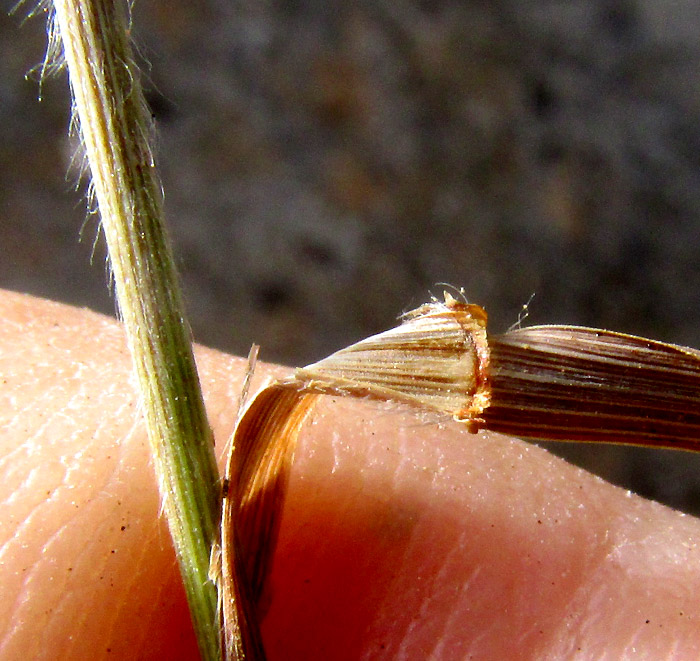
Where grass blades connect with the stems, often there's a collar-like ligule. When present, ligules of some genera are composed of hairs, others of long bristle, and others of membranous walls like the one seen above. Sometimes such wall-like ligules are deeply cut, or they can be solid, like the one above. Sometimes such ligules can be much taller than the above, or little more than a low rim. The one shown above is proper for Bromus. Also, notice the stem's long, downward-pointed, soft hairs.
Currently about 160-170 Bromus species are recognized worldwide. The Flora of North America lists 52 species for North America, of which 28 are native and 24 are introduced, so it's clear that brome grass species often become invasive. In our upland, central Mexican region about six species can be found. Our plant, with its dangling spikelets and soft-hairy lemmas with short awns, reveals itself as BROMUS ANOMALUS, often known as Mexican Brome, as well as Nodding Brome.
This grass bears English names because Bromus anomalus occurs in North America, as well as south through Mexico to Oaxaca. The Flora of North America describes it as growing on rocky slopes in western Texas and adjacent Mexico, but other sources show it occurring generally in the western US and southwestern Canada. Part of the discrepancy may be that some authorities consider the very similar Bromus porteri to be just a variation of Bromus anomalus, while others regard it as a full species. Whatever the case, our grass wasn't a particularly rare one.
Moreover, the Mexican government's Malezas de México website, "Mexican Weeds," describes the habitat of Bromus anomalus as pine/oak forests, dry scrub and grasslands, and occasionally in disturbed areas. So, instead of our grass being specially adapted just to this severe habitat, it's a flexible taxon able to handle many habitats -- a desirable feature during the ongoing mass extinction of species caused by global climate change and human-caused habitat destruction.
The species is reported as edible for herbivores, and sometimes is used in habitat restoration and to control erosion. It's a perennial, but without rhizomes, so its fibrous roots should do a good job holding soil in place.